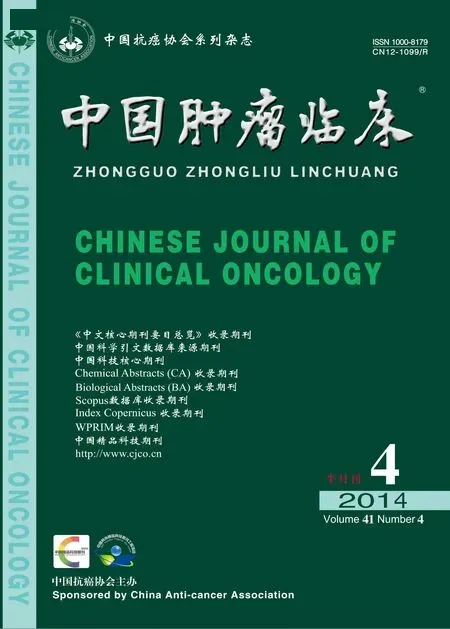干细胞基因Musashi-1研究进展*
王 颜 樊利芳
Musashi-1作为Musashi家族的一员,除在哺乳动物的胚胎和成体神经干细胞中强表达外,于胃黏膜、肠、乳腺、表皮及毛囊中的上皮祖细胞亦有表达,其功能与神经干细胞和上皮祖细胞维持干细胞特性及不对称分裂有关,其机能降低可破坏生殖系干细胞自我更新与分化的平衡,导致生殖系干细胞分化不成熟[1-3]。Musashi-1通过调节转录后的翻译过程来保持干细胞处于未分化的状态,并参与到肿瘤形成发展[2]。
1 Musashi-1结构与功能
1.1 Musashi-1基因的发现
第1个Musashi家族成员即Musashi-1,由362个氨基酸组成,基因定位于染色体12q24.1~31,蛋白分子量为39 kD,首先在果蝇中得到鉴定,并且研究发现通过建立果蝇Musashi-1基因敲除模型,Musashi-1参与调节靶分子mRNA翻译,在调节外胚层感觉器官前体细胞(sensory organ precursor cells,SOPs)的不对称性分裂中起着重要作用。而果蝇的神经干细胞/前体细胞的不对称分裂是其是否分化成熟的标志,Musashi突变的果蝇SOPs未能进行不对称性分裂,即发育成熟障碍[1,4-5]。
1.2 Musashi-1基因的功能
1.2.1 维持干细胞功能 Musashi-1在神经干细胞中有维持干细胞功能的作用,并在口腔、胃肠道、皮肤、毛囊等组织器官的成体干细胞中均有表达。一般认为这种作用与Notch信号通路的激活以及Cyclin依赖的激酶抑制剂P21WAF-1有关,这两者的功能与Musashi-1在细胞周期和调节分化中的作用一致[6]。Musashi-1下调可以导致细胞有丝分裂和凋亡的增加[7]。
1.2.2 参与信号通路 Musashi-1通过调节Notch、Wnt/β-catenin信号通路[8],与肿瘤的发生、发展密切相关。在果蝇中枢神经系统的发育过程中,其体内的细胞命运决定子(Numb)与Notch受体的胞内域(NICD)结合,诱导Notch蛋白从表面转位到核内体,然后降解,从而抑制Notch信号通路。Musashi-1通过抑制Numb的转录,以及诱导Notch通路下游靶基因HES(hairy and enhancer of spilt)-1启动子的转录激活,从而产生对Notch信号通路的正调节作用[4,9],有利于神经干细胞的自我更新,Musashi-1还可能通过这条信号通路维持除神经干细胞之外的其他干细胞的特性。
在乳腺上皮细胞中,Musashi-1通过提高生长因子PLFl水平以及对Wnt通路抑制因子DKK3进行抑制[8,10],从而调节Wnt及Notch信号通路,参与体内肿瘤的发生与发展。
2 Musashi-1在肿瘤中的表达
近年关于肿瘤发生机制中肿瘤干细胞学说备受瞩目。Musashi-1作为干细胞候选基因,在肿瘤干细胞研究中已成为不可或缺的研究对象。
2.1 神经系统肿瘤
检测发现,在人神经胶质细胞瘤中神经干细胞标志物Musashi-1高表达,并与肿瘤恶性程度(WHO分级)和增殖活性呈正相关[11],但是Musashi-1并不与肿瘤增殖抗原(proliferating cell nuclear antigen,PCNA)或Ki-67共表达,却可与其他干细胞标志物如CD133、Nestin共表达[12]。神经胶质细胞瘤患者的手术切除组织,在经无血清培养、体外扩增形成的神经球中,检测到Musashi-1及其他神经干细胞标志物Nestin、Sox2等基因高表达,神经球中的细胞在裸鼠体内还可生长为高级别浸润型移植瘤,并且组织学特性与亲代肿瘤极为相似[13]。
2.2 消化系统肿瘤
2.2.1 口腔鳞癌 研究发现在口腔正常黏膜-不典型增生-癌变过程中Musashi-1表达水平逐渐升高,且与CD133共同表达,其表达量随着恶变进展递增,而且与肿瘤的组织类型和分期有显著相关性,为利用CD133和Musashi-1作为分子靶点治疗带来了新启示[14]。
2.2.2 食管癌 已有研究发现,正常食管黏膜中Musashi-1不表达或极低表达,Barret's食管低表达,而在腺癌中高表达。腺癌组Musashi-1 mRNA高于Barret's食管组或正常黏膜,而Barret's食管组高于正常食管黏膜[15-16]。另一项食管鳞癌的研究发现,Musashi-1阴性的患者化疗有效,而Musashi-1强阳性患者化疗后复发,预后差。建议可将Musashi-1作为食管癌化疗组织反应和预后判断的候选指标[17]。
2.2.3 胃癌 Wang等[18]报道,胃癌前病变(肠上皮化生和不典型增生)及腺癌Musashi-1表达均升高。在肠上皮化生胃组织和肠型胃癌中表达率分别为85%和81%,并且发现Musashi-1表达与TNM分期有关,晚期胃癌Musashi-1表达水平较高。但是Musashi-1表达强度与肿瘤的分化程度、浸润深度以及胃癌患者对化疗反应及其预后之间的关系差异无统计学意义,与食管鳞癌报道[15-17]结果相反。Akasaka等[19]发现Musashi-1在不完全型与完全型肠上皮化生表达率分别为48.4%和22.6%。此外,从胃癌细胞株AGS和MKN45分选的 SP(side population)细胞中也发现Musashi-1和CD133表达水平高于非SP细胞[20]。以上研究结果提示,Musashi-1表达是胃癌发生过程中的早期事件,可作为胃癌肿瘤干细胞标志物。
2.2.4 胆囊癌 Liu等[21]发现胆囊腺癌组织中Musashi-1阳性率明显高于癌旁组织,与干细胞相关基因ALDH1表达水平具有明显一致性,并且发现Musashi-1高度表达的胆囊癌恶性程度及淋巴结转移率更高。这项研究结果提示,Musashi-1可能在胆囊癌的发生、发展中起着重要作用,可成为诱导胆囊癌分化成熟的理想靶点。
2.2.5 小肠及结直肠癌 本课题组前期对38例小肠腺癌的组织标本进行了免疫组织化学检测,发现Musashi-1的阳性率为71%(27/38),并且表达率明显高于正常组,这项研究仍在进行中,目前结果可以推测Musashi-1可能参与了小肠腺癌的发生发展。另外,已有研究证明Musashi-1过表达通过Wnt及Notch通路与结直肠癌密切相关,并可能干预肿瘤的浸润深度和预后[22]。本课题组前期研究使用免疫组织化学方法检测Musashi-1在结直肠腺瘤和腺癌组织芯片中表达,结果显示其表达率分别为50%(4/8)和67%(46/69)[23]。而Musashi-1 mRNA在结肠癌组织中表达率仅为 27%(21/77)[24]。在结直肠癌组织中Musashi-1可能通过调控细胞增殖、抑制细胞分裂参与肿瘤的发生。采用siRNA方法敲除HCT116结肠癌细胞Musashi-1基因,导致裸鼠移植瘤生长停滞,HCT116细胞增殖减缓,放射诱导的细胞凋亡增加,Notch-1下调及P21WAF-1上调[7]。
2.3 生殖系统肿瘤
Wang等[10]发现Musashi-1基因在乳腺癌组织中高表达,能促进乳腺癌细胞的增殖,并且与乳腺癌的淋巴结转移及5年生存率相关。另有研究表明Musashi-1表达可通过基因启动子CpG位点甲基化调节,将乳腺癌细胞株去甲基化后,Musashi-1 mRNA表达水平升高。乳腺癌组织标本中免疫组织化学方法亦证实低甲基化Musashi-1强表达,而高甲基化Musashi-1阴性或弱表达。此外,研究发现Musashi-1基因诱导肿瘤转移以及导致肿瘤细胞耐药,影响肿瘤预后[25]。以上研究结果提示Musashi-1是乳腺癌癌变过程中的重要基因,并且可能因为甲基化失活而发生表达异常增高。
3 展望
综上所述,RNA结合蛋白Musashi-1作为一个干细胞候选基因,在干细胞相关疾病的发生机制中起重要作用。干细胞候选基因在一些肿瘤细胞共表达,使用这些标志物分选的肿瘤细胞亦具有干细胞特性,由此推测,Musashi-1可能还是一个肿瘤干细胞标志物。鉴于Musashi-1在干细胞和肿瘤干细胞中的重要作用,相信在不久的将来,Musashi-1会被用于干细胞相关疾病尤其是肿瘤的诊断、靶向治疗或预后判断。
1 Nakamura M,Okano H,Blendy JA,et al.Musashi,a neural RNA-binding protein required for Drosophila adult external sensory organ development[J].Neuron,1994,13(1):67-81.
2 Okabe M,Imai T,Kurusu M,et al.Translational repression determines a neuronal potential in Drosophila asymmetric cell division[J].Nature,2001,411(6833):94-98.
3 Sutherland JM,McLaughlin EA,Hime GR,et al.The Musashi family of RNA binding proteins:master regulators of multiple stem cell populations[J].Adv Exp Med Biol,2013,786:233-245.
4 Okano H,Kawahara H,Toriya M,et al.Function of RNA-binding protein Musashi-1 in stem cells[J].Exp Cell Res,2005,306(2):349-356.
5 Ratti A,Fallini C,Cova L,et al.A role for the ELAV RNA-binding proteins in neural stem cells:stabilization of Msi1 mRNA[J].J Cell Sci,2006,119(Pt 7):1442-1452.
6 Nikpour P,Baygi ME,Steinhoff C,et al.The RNA bingding protein Musashi1 regulates apoptosis,gene expression and stress granule formation in urothelia carcinoma cells[J].J Cell Mol Med,2011,15(5):1210-1224.
7 Sureban SM,May R,George RJ,et al.Knockdown of RNA binding protein musashi-1 leads to tumor regression in vivo[J].Gastroenterology,2008,134(5):1448-1458.
8 Wang XY,Yin Y,Yuan H,et al.Musashi1 modulates mammary progenitor cell expansion through proliferin-mediated activation of the Wnt and Notch pathways[J].Mol Cell Bio,2008,28(11):3589-3599.
9 Imai T,Tokunaga A,Yoshida T,et al.The neural RNA-binding protein Musashi1 translationally regulates mammalian numb gene expression by interacting with its mRNA[J].Mol Cell Biol,2001,21(12):3888-3900.
10 Wang XY,Penalva LO,Yuan H,et al.Musashi1 regulates breast tumor cell proliferation and is a prognostic indicator of poor survival[J].Mol Cancer,2010,9:221.
11 Dahlrot RH,Hansen S,Herrstedt J,et al.Prognostic value of Musashi-1 in gliomas[J].J Neurooncal,2013,115(3):453-461.
12 Ma YH,Mentlein R,Knerlich F,et al.Expression of stem cell markers in human astrocytomas of different WHO grades[J].J Neurooncol,2008,86(1):31-45.
13 deCarvalho AC,Nelson K,Lemke N,et al.Gliosarcoma stem cells undergo glial and mesenchymal differentiation in vivo[J].Stem Cells,2010,28(2):181-190.
14 Ravindran G,Devaraj H.Aberrant expression of CD133 and musashi-1 in preneoplastic and neoplastic human oral squamous epithelium and their correlation with clinicopathological factors[J].Head Neck,2012,34(8):1129-1135.
15 Vega KJ,May R,Sureban SM,et al.Identification of the putative intestinal stem cell marker doublecortin and CaM kinase-like-1 in Barrett's esophagus and esophageal adenocarcinoma[J].J Gastroenterol Hepatol,2012,27(4):773-780.
16 Bobryshev YV,Freeman AK,Botelho NK,et al.Expression of the putative stem cell marker Musashi-1 in Barrett's esophagus and esophageal adenocarcinoma[J].Dis Esophagus,2010,23(7):580-589.
17 Kuroda J,Yoshida M,Kitajima M,et al.Utility of preoperative chemoradiotherapy for advanced esophageal carcinoma[J].J Gastroenterol Hepatol,2012,27(Suppl 3):88-94.
18 Wang T,Ong CW,Shi J,et al.Sequential expression of putative stem cell markers in gastric carcinogenesis[J].Br J Cancer,2011,105(5):658-665.
19 Akasaka Y,Saikawa Y,Fujita K,et al.Expression of a candidate marker for progenitor cells,Musashi-1,in the proliferative regions of human antrum and its decreased expression in intestinal metaplasia[J].Histopathology,2005,47(4):348-356.
20 Schmuck R,Warneke V,Behrens HM,et al.Genotypic and phenotypic characterization of side population of gastric cancer cell lines[J].Am J Pathol,2011,178(4):1792-1804.
21 Liu DC,Yang ZL,Jiang S.Identification of musashi-1 and ALDH1 as carcinogenesis,progression,and poor-prognosis related biomarkers for gallbladder adenocarcinoma[J].Cancer Biomark,2010,8(3):113-121.
22 Kanwar SS,Yu Y,Nautiyal J,et al.The Wnt/beta-catenin pathway regulates growth and maintenance of colonospheres[J].Mol Cancer,2010,9:212.
23 Fan LF,Dong WG,Jiang CQ,et al.Expression of putative stem cell genes Musashi-1 and beta1-integrin in human colorectal adenomas and adenocarcinomas[J].Int J Colorectal Dis,2010,25(1):17-23.
24 Dimitriadis E,Trangas T,Milatos S,et al.Expression of oncofetal RNA-binding protein CRD-BP/IMP1 predicts clinical outcome in colon cancer[J].Int J Cancer,2007,121(3):486-494.
25 Kagara N,Huynh KT,Kuo C,et al.Epigenetic regulation of cancer stem cell genes in triple-negative breast cancer[J].Am J Pathol,2012,181(1):257-267.

